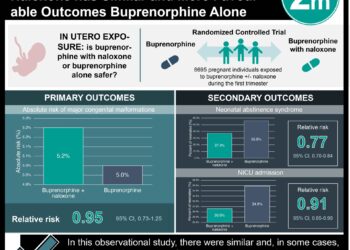Study details opioid prescribing patterns to US children and young adults in 2019
1. Based on a prescription-dispensing database including a large majority of US pharmacies, 3.5% of children and young adults aged 0 to 21 years were prescribed opioids in 2019.
2. 45.6% of these opioid prescriptions met at least one criterion for high-risk prescription such as long duration of supply, high dosage, or overlap with a benzodiazepine prescription.
Evidence Rating Level: 2 (Good)
Study Rundown: Opioid medications are a cornerstone of pain management in children and young adults as in other demographic groups. As the crisis of opioid dependence and overdose continues in the United States, however, it is essential to understand and closely monitor how often and in what manner opioids are prescribed. This study reports cross-sectional data from a large database of dispensed prescriptions including most pharmacies in the US. Dentists and surgeons together accounted for a majority of prescriptions, suggesting that much of opioid prescription in these age groups is in the acute post-procedural setting. 45.6% of overall prescriptions met at least one of the study criteria for being high risk. 41.8% of prescriptions were for longer than 3 days, and 3.8% were for longer than 7 days. Although the study design does not allow judgment of whether individual prescription lengths were appropriate, the indications for long-duration prescriptions in the pediatric population are limited. 8.4% of prescriptions to children aged 0-11 were for codeine and 7.7% for tramadol, both of which are contraindicated in children. Interpretation of the study results is limited by the study’s lack of correlation with parallel measures in previous years. Overall, the reported numbers are consistent with a continued decline in opioid prescription to children and young adults since 2015. The statistics on high-risk prescribing, however, indicate that national practice is still catching up to literature and clinical guidelines, which favor nonopioid analgesics even for many perioperative indications in children.
Click to read the study in Pediatrics
Relevant Reading: Temporal trends in opioid prescribing practices in children, adolescents, and younger adults in the US from 2006 to 2018
In-Depth [cross-sectional study]: This cross-sectional analysis examined data from the 2019 IQVIA Longitudinal Prescription Database, which included 92% of retail pharmacies and 70% of mail-order pharmacies and pharmacies in long-term care facilities. About 4 million opioid prescriptions were dispensed to about 3.1 million patients aged 0-21, comprising 2.8% of the total opioid prescriptions in the database. 3.5% of US children and young adults received at least one prescription from an included pharmacy, and 14.3% of these patients received multiple prescriptions. More female (3.8%) than male (3.1%) patients were prescribed opioids, and proportions varied between census regions, with the South highest at 4.1% and Northeast lowest at 2.5%. High-volume prescribers accounted for 53.3% of overall prescriptions and 53.1% of high-risk prescriptions, indicating that high volume did not correspond with riskier prescribing. “High-risk” metrics included supplies greater than 3 days or 7 days prescribed to opioid-naïve patients, prescriptions for codeine and tramadol to patients 0-11 years old, prescription strengths of at least 50 morphine milligram equivalents (MMEs) per day for patients 12-21 years old, and overlap with a benzodiazepine prescription. Prescriptions meeting 1 or more of these metrics were considered high-risk. 11.5% of prescriptions to patients aged 12-21 were for daily doses at least 50 MMEs. 4.6% of prescriptions in the same age group overlapped by at least 1 day with a benzodiazepine prescription.
Image: PD
©2021 2 Minute Medicine, Inc. All rights reserved. No works may be reproduced without expressed written consent from 2 Minute Medicine, Inc. Inquire about licensing here. No article should be construed as medical advice and is not intended as such by the authors or by 2 Minute Medicine, Inc.







